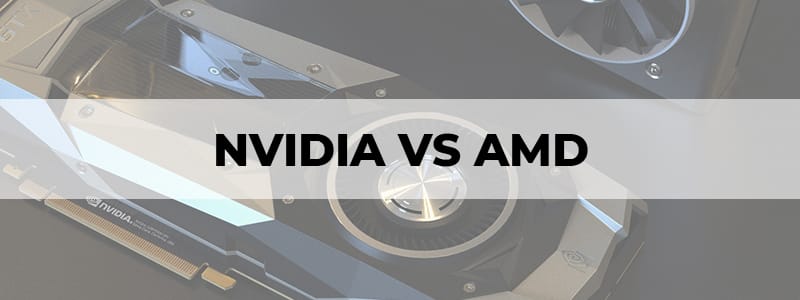
Whether we’re talking about AMD graphics cards VS Nvidia or AMD VS Intel CPUs, we have to consider performance, power, prices, and particular features that distinguish different products from each other whenever in the realm of building a gaming PC.
The best graphics card debate is one that has raged on for a while, with no end in sight. Your personal preferences should inform your choices, but how do you know which needs and wants should be prioritized over others?
AMD VS Nvidia GPUs: Why The Comparison?
Both companies are considered heavyweights in the world of gaming PCs; while AMD has been around since the early 60s (1959, to be exact), making Nvidia half its age at a rough estimate, the latter is considered to be king by many. How much truth there is to this claim, however, is something we’ll examine in detail.
AMD’s brand was brought down starting in the first half of the previous decade, finding itself struggling to compete in the CPU market with Intel and in the GPU world with Nvidia. Their FX CPUs failed to capture the market as well as Intel did, and their GPUs were pushed to being considered low-end products.
While Nvidia is still worth around double what AMD is, AMD saw a sharp rise starting 2017. Here’s a name you might be very familiar with or at least have heard – Ryzen, AMD’s CPUs that are now a mainstay of gaming PCs. They followed up this success with Navi GPUs (7nm, RDNA-based) in just two short years.
2020 brought unique challenges for both companies (COVID contingencies notwithstanding) and the AMD Vs Nvidia fight is just heating up. The AMD Big Navi has promising specs that could give the Nvidia Ampere a tough time. With GPUs like the Radeon RX 5700 XT, and the way things stand now, all parties involved have their pros and cons.
AMD Radeon VS Nvidia GeForce: Our Comparison
We see this comparison being shaken up with the advent of both the Navi and the Ampere but at this moment in time, a snapshot of what you can expect from both camps is the way to go.
We’ll be looking at it in terms of (as previously hinted) price, performance for gaming, particular features and the technology they employ, the drivers and software, and power consumption.
Price
AMD has been known for its budget buys for years. Whatever Nvidia offered at a certain price, AMD offered better bang for your buck at the same price level, but as we added more hundreds to the budget, Nvidia began to shine.
While AMD’s older GPUs are still better than Nvidia’s products in terms of the low price and the heaps of features they promise, some would argue it’s worth it to up your budget to get exponentially more, if it’s at all possible. If not, AMD’s RX 500 cards remain the best value buys in the market, even if Nvidia’s latest offerings are actually better than AMD’s latest.
In fact, at the mid-range, it gets hard to compare AMD and Nvidia (with their Navi and GTX/RTX models, respectively). Ultimately, however, we can chalk up a win to AMD when it comes to value proposition solely for the fact that for most gamers they’re offering the most value in the most that most gamers can (mostly?) afford.
Performance & Power
While different GPUs have different GPU target markets, the current-gen Navi and Turing GPUs for their makers AMD and Nvidia, respectively, cut it pretty close in terms of efficiency, power and performance.
In the popular mid-range that we’ve previously talked about, AMD still inches ahead of Nvidia, but at any other price range, whether low-end or high-end, Nvidia definitively wins, even when their lithography is previous gen, which means AMD hasn’t exactly improved on efficiency.
This is painfully apparent in the new Navi GPUs from AMD: a 50% improvement in performance per watt in their own tech still couldn’t map the gap in deficiency between the two companies. Even as Big Navi improves things for AMD, so does the Ampere for Nvidia, so we’re not exactly holding our breath to see them suddenly make big leaps in this department. For performance and power, we’d give Nvidia our vote.
Features & Technology
While a lot of these might be considered “inessential”, Nvidia leads the way in terms of enhancements: gamers’ beloved ray tracing and DirectX 12 Ultimate, as well as Vulkan RT, are all mainstays of gaming. Ray tracing, in particular, is shaping up to become the future of gaming in terms of rendering graphics, even for low-spec GPUs through DLSS and real-time denoising through Tensor cores.
Conclusion
Pound for pound, Nvidia seems to come out on top in most departments, but you wouldn’t be losing a lot with an AMD (and you might be saving a lot in terms of money!). It all boils down to prioritizing your specific needs, but if you ask us, even when penny-pinching, we’d look towards that Nvidia GPU.
